Advertisements
Advertisements
प्रश्न
Distinguish between perfectly elastic demand and perfectly inelastic demand.
उत्तर
|
Perfectly elastic demand
|
Perfectly inelastic demand
|
| When a slight or zero change in the price brings about an infinite change in the quantity demanded of that commodity, it is called perfectly elastic demand. | When a percentage change in price has no effect on the quantity demanded of a commodity, it is called perfectly inelastic demand. |
|
It implies that the demand is infinitely responsive to any change in the price of the good.
|
It implies that the demand is completely unresponsive to any change in the price of the good.
|
| It is represented symbolically as: Ed = `(% ∆"Q")/(%∆"P")` = ∞ | It is represented symbolically as: Ed = `(% ∆"Q")/(%∆"P")` = 0 |
 |
|
|
For example, a 10% fall in price may lead to an infinite rise in demand.
|
For example, a 20% fall in price will have no effect on the quantity demanded.
|
APPEARS IN
संबंधित प्रश्न
Distinguish between Relatively elastic demand and relatively inelastic demand.
The demand curve is parallel to the X-axis in the case of ______.
When the percentage change in quantity demanded is more than the percentage change in price, the demand curve is ______.
Perfectly elastic demand : Ed = ∞ : : _______ : Ed = 0
Complete the correlation:
Rectangular hyperbola : ______ : Steeper demand curve : Relatively inelastic demand.
Assertion and Reasoning type of question:
- Assertion (A): The degree of price elasticity is less than one in case of relatively inelastic demand.
- Reasoning (R): The change in demand is less than the change in price.
In the following diagram, AE is the linear demand curve of a commodity. On the basis of the given diagram state whether the following statement is True or False. Give a reason for your answer.

Demand at point ‘C’ is relatively elastic demand.
In the following diagram, AE is the linear demand curve of a commodity. On the basis of the given diagram state whether the following statement is True or False. Give a reason for your answer.

Demand at point ‘B’ is unitary elastic demand.
In the following diagram, AE is the linear demand curve of a commodity. On the basis of the given diagram state whether the following statement is True or False. Give a reason for your answer.

Demand at point ‘D’ is perfectly inelastic demand.
In the following diagram, AE is the linear demand curve of a commodity. On the basis of the given diagram state whether the following statement is True or False. Give a reason for your answer.

Demand at point ‘A’ is perfectly elastic demand.
Identify and define the degrees of elasticity of demand from the following demand curve.
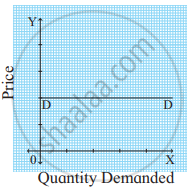
Identify and define the degrees of elasticity of demand from the following demand curve.
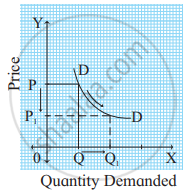
Relatively elastic demand : Ed > 1 :: Relatively inelastic demand : ______.
Demand curve is parallel to 'Y' axis in case of ______.
Assertion (A): The slope of demand curve is a rectangular hyperbola in case of unitary elastic demand.
Reasoning (R): In unitary elastic demand, percentage change in price leads to more than proportionate change in quantity demanded.
Identify & explain the concept from the given illustration
Kiran’s demand for milk remained unchanged even when its price increased by 10%.
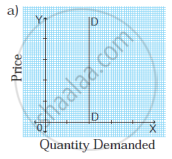 |
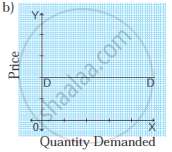 |
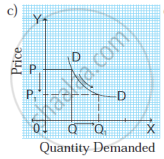 |
 |
Questions:
- Identify the types of price elasticity of demand from above diagram. (2m)
- Write slope of demand curve in above diagrams. (2m)
Explain the types of price elasticity of demand.
Complete the correlation.
Perfectly elastic demand : Ed = ∞ :: ______ : Ed = 1.
When the percentage change in quantity demanded is Less than the percentage change in price the demand curve is ______
Identify and explain the following concept.
Ramesh's demand for salt remained unchanged lnspite of a 10% rise in its price.
Study the following figure and answer the question given below it.
Identify the price elasticity of demand from the following diagram:
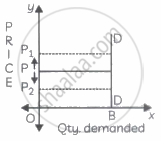
Study the following figure and answer the question given below it.
Identify the price elasticity of demand from the following diagram:
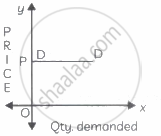
Study the following figure and answer the question given below it.
Identify the price elasticity of demand from the following diagram:

Study the following figure and answer the question given below it.
Identify the price elasticity of demand from the following diagram:
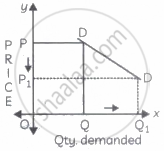
Distinguish between:
Unitary elastic demand and Relatively elastic demand
Identify and explain the concept from the given illustration:
A fall in the price of ice cream by 50% resulted in a 20% rise in its demand.
Study the following diagram and answer the questions:
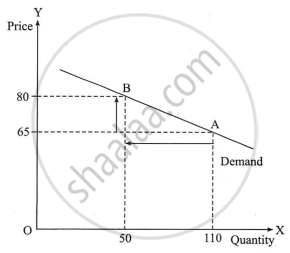
Questions:
- Calculate the price elasticity of demand using the ratio method.
- Find out the type of price elasticity of demand.
Identify and explain the concept from the given illustration:
A fall in the price of medicines by 30% resulted in no rise in demand for it.
Find the odd word out:
Types of price elasticity of demand:
Find the odd word out:
Products having relatively inelastic demand:
Complete the correlation:
Perfumes : ______ : : Medicines : Relatively inelastic demand.
Identify and explain the concept from the given illustration:
Demand for perfumes increased by 10% when its price decreased by 30%.

